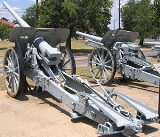
10 cm K 17
Encyclopedia
The 10 cm Kanone 17 was a field gun used by Germany
in World War I
and World War II
.
was deemed insufficient in combat and Krupp
designed a new, longer (L/45) barrel that was mounted on the K 14's carriage. This made the gun too heavy to be transported as a single load, the barrel had to be removed and stowed on its own transport wagon. The ramps visible in the picture (see right), served to guide the barrel transport wagon into position to align the barrel with the recoil system to allow it to be winched into battery. They are fixed in place on this example, but were generally removable.
The K 17 used either a hydro-pneumatic or hydro-spring recoil system, presumably depending on manufacturer.
, variable recoil was deleted and the gun could not be broken down for transport. This was called the K 17/04, about a thousand were ordered in August 1917.
, mainly in the coastal defense role. Here the Kanone 1917 and K 17/04 soldiered on along with the 10 cm Kanone 1918, these three most modern types saw excellent service throughout World War II.
Germany
Germany , officially the Federal Republic of Germany , is a federal parliamentary republic in Europe. The country consists of 16 states while the capital and largest city is Berlin. Germany covers an area of 357,021 km2 and has a largely temperate seasonal climate...
in World War I
World War I
World War I , which was predominantly called the World War or the Great War from its occurrence until 1939, and the First World War or World War I thereafter, was a major war centred in Europe that began on 28 July 1914 and lasted until 11 November 1918...
and World War II
World War II
World War II, or the Second World War , was a global conflict lasting from 1939 to 1945, involving most of the world's nations—including all of the great powers—eventually forming two opposing military alliances: the Allies and the Axis...
.
Development
The range of the 10 cm K 1410 cm K 14
The 10 cm Kanone 14 was a field gun used by Germany and Bulgaria in World War I. It was intended to replace the 10 cm K 04. In many ways it was a heavily modified K 04 intended to be able to engage aircraft. It was mounted on a firing platform to give it fast 360° traverse...
was deemed insufficient in combat and Krupp
Krupp
The Krupp family , a prominent 400-year-old German dynasty from Essen, have become famous for their steel production and for their manufacture of ammunition and armaments. The family business, known as Friedrich Krupp AG Hoesch-Krupp, was the largest company in Europe at the beginning of the 20th...
designed a new, longer (L/45) barrel that was mounted on the K 14's carriage. This made the gun too heavy to be transported as a single load, the barrel had to be removed and stowed on its own transport wagon. The ramps visible in the picture (see right), served to guide the barrel transport wagon into position to align the barrel with the recoil system to allow it to be winched into battery. They are fixed in place on this example, but were generally removable.
The K 17 used either a hydro-pneumatic or hydro-spring recoil system, presumably depending on manufacturer.
Anti-aircraft role
Despite the recognition that the K 17 would not have any anti-aircraft role, most of the heavy and expensive features added to the K 14 in a failed bid to equip it as an AA gun were retained. Presumably this was to hasten the switchover from production of the K 14 to the K 17. A simpler version of the K 17 was designed in 1917 that harkened back to the K 04 in many ways. The complex sighting system was dropped in favor of one based on the sights used on the 15 cm sFH 1315 cm sFH 13
The 15 cm schwere Feldhaubitze 13 was a heavy field howitzer used by Germany in World War I and World War II.-History:...
, variable recoil was deleted and the gun could not be broken down for transport. This was called the K 17/04, about a thousand were ordered in August 1917.
Counter battery gun
Because of its perceived value as an anti-aircraft weapon the gun was a difficult piece to manufacture. Despite a few K 04s shooting down balloons during the war, these weapons never fulfilled a useful air defense niche. In 1914 few active army corps had heavy guns within their organization. These pieces were often found in reserve units. By 1918 all corps incorporated heavy guns. The Foot Artillery organization was typically made of a mixture of two howitzer batteries, with one battery of heavy guns per Foot Artillery Battalion. Overall it appears the 10 cms did find useful service. They served as an excellent long-range counter battery weapon and were more than passable as an anti-personnel weapon. They were well paired with the 15 cms, which did more commonly serve in the anti-personnel role.Fate
Germany was forbidden these guns by the Versailles Treaty and was supposed to scrap or sell all existing weapons. Some were sold to Sweden and Romania after the war, but some were hidden and saw service in World War IIWorld War II
World War II, or the Second World War , was a global conflict lasting from 1939 to 1945, involving most of the world's nations—including all of the great powers—eventually forming two opposing military alliances: the Allies and the Axis...
, mainly in the coastal defense role. Here the Kanone 1917 and K 17/04 soldiered on along with the 10 cm Kanone 1918, these three most modern types saw excellent service throughout World War II.

